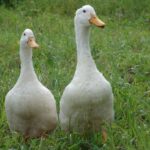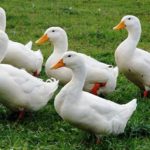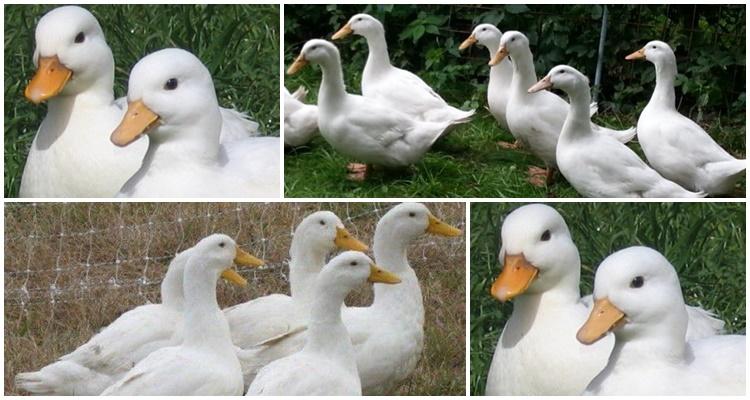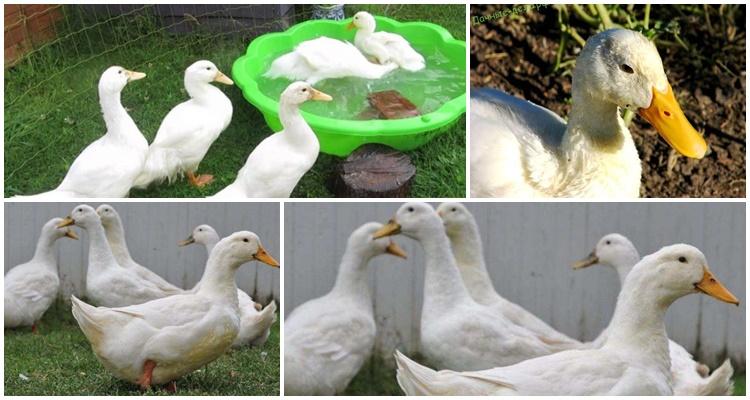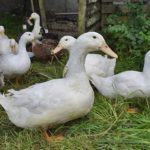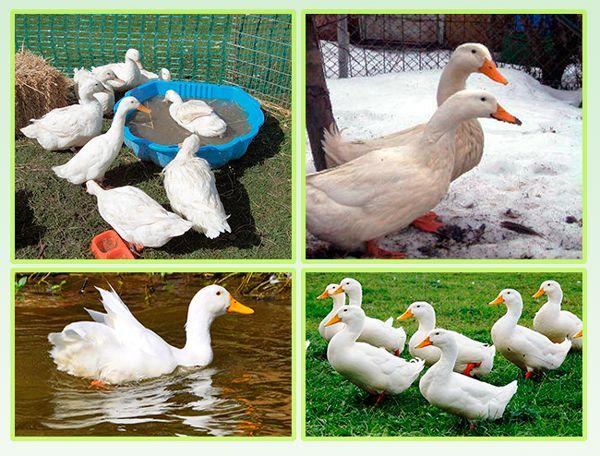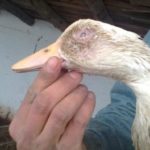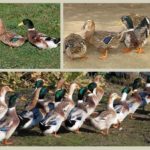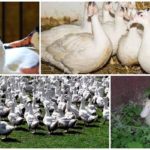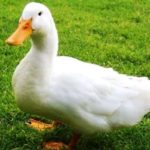Bashkir ducks of the Agidel breed are a new hybrid species of poultry that farmers are just beginning to get acquainted with. It received official recognition in 2012. Snow white duck meat is low in fat. The breed is characterized by early maturity and high egg production. During the summer you can hatch 2-3 batches of ducklings. In general, agidels are easy to care for. But there are nuances in breeding chicks, knowledge of which will help raise healthy and well-fed broilers.
History of the breed
Bashkir duck appeared in an attempt to improve the Pekingese breed. The work began at the beginning of the 21st century. Breeders set the task of increasing the amount of meat and reducing its fat content. The crossbreeding involved Blagovarian ducks, the Super-M cross breed and Indian runners. The new type of poultry was named agidel. During selection, two subspecies were identified, numbers 345 and 34.
Under the name of Bashkir ducks are also known cross-breed favorite. The intermediate species was also obtained during work on improving Peking ducks. It was bred at the Blagovarsky plant, where the Agidel duck also appeared, but is not its subspecies. The Agidel breed is mistakenly called Adyghe or Adyghe duck. There is no such breed.
Description and characteristics of the Agidel duck
What does a hybrid breed of poultry look like:
- massive elongated body;
- low landing;
- pure white plumage color;
- orange wide beak;
- strong paws.
Agidel is a broiler breed characterized by early maturity.
The differences between duck subspecies are minor and relate to performance:
| Parameter | Agidel 345 | Agidel 34 |
| Weight in kilograms | 3 | 3,05 |
| Costs in feed units per kilogram of weight | 2,27 | 2,28 |
| Percentage of fat in meat | 28,2 | 28,4 |
| Number of eggs from one individual per year | 345 | 227 |
Ducks begin to lay eggs at the age of six months. The eggs are large, weighing 77-95 grams.
Birds of the Agidel breed are calm in nature. They scream loudly if they sense danger. Males do not fight among themselves during the mating season.
Advantages and disadvantages
The breed is distinguished by high egg production, despite its meat orientation, and resistance to leukemia. During the season, several batches of ducklings grow up. A high-quality feather is an additional bonus to tender dietary meat, bringing economic benefits. Agidel ducks are able to graze in the meadow and do without swimming. To bring the survival rate to an average of 80 percent, the eggs are kept warm in an incubator.
Features of maintenance and care
Raising Agidel ducks at home does not require a specially equipped room or pond. The main requirement is the absence of drafts. Conditions for growing the breed:
- the density of adults is 3 ducks per square meter;
- temperature in winter - above +5 degrees;
- the floor in the duck house is covered with sawdust, sunflower seed husks, and fresh straw;
- The thickness of the litter in winter is 30 centimeters, in summer – 20 centimeters, for newborn ducklings – 5 centimeters.
An area for walking ducks should be fenced off near the ducklings. The pond will be replaced by a bowl of water for the birds. In summer, the container should be placed outside so that the ducks can bathe while walking. In winter, water should be placed in the nesting box for two hours a day or in a separate room and the birds should be taken there for a walk and a swim.
Before moving in a new batch of ducklings, the old bedding is removed and the duckling house is disinfected. The top layer must be renewed every 2 days and not allowed to dry out into a crust.
For a flock of ducklings of less than a hundred individuals, you can prepare cardboard boxes or cages with bedding at the bottom. It is not recommended to release chicks as a whole flock into a large room. Agidel ducks are afraid of hands and are difficult to keep up with.To keep birds without walking, a ventilation system or vents for ventilation are installed in the nesting house. Ducks become aggressive from constant exposure to musty air.
You should also properly organize the lighting. In the first two weeks of life, ducklings need light 24 hours a day. Then daylight hours are reduced to nine hours.
Diet
Feeding high protein whole grains helps Agidel ducks gain maximum weight. The basis of nutrition is barley, oats, wheat, and corn. For normal digestion and prevention of vitamin deficiencies, the diet of birds includes:
- fresh grass;
- beans;
- beet tops;
- vegetables - boiled potatoes, carrots, fodder beets;
- fish fat;
- sunflower cake;
- wheat, oat bran;
- bone meal;
- chalk.
In winter, ducks are given silage and grass meal. To digest tough plant stems, birds need solid food additives - crushed shells, fine gravel.
The hatched ducklings begin to be fed with crushed boiled eggs. Then they add corn flour, low-fat cottage cheese, mixed in meat or fish broth.
Ducks require plenty of water. Potassium permanganate is added to the water for chicks twice a week. A pale pink solution of potassium permanganate prevents the development of intestinal diseases. Fattened birds are not limited in food. Laying hens are fed 4 times a day.
How to breed poultry
To hatch chicks of the Agidel breed, eggs of a regular oval shape with a smooth shell are selected.They are placed in an incubator and kept for 26 days under the following conditions:
- the average temperature is 38 degrees, in the first 14 days keep it at 37.8-38 degrees Celsius, from the fifteenth day gradually increase to 38.7;
- maintain humidity at 70 percent for the first two weeks, then reduce to forty;
- so that the embryo does not move from the center, the eggs need to be turned 10 times a day at regular intervals;
- Cool the eggs twice a day at equal intervals.
While waiting for the chicks to hatch, it is recommended to increase the air humidity in the incubator to seventy percent so that the shell becomes softer and it is easier for the chicks to break through it. Conditions for keeping hatched ducklings:
- room temperature in the first week +38 degrees;
- in the second week, reduce heating to 26 degrees, and in the third - 18 degrees;
- optimal humidity - 60-70 percent;
- The planting density in the first five days is 30 individuals per square meter.
If the ducklings are huddled together, it means they are cold. You can increase heating using electric radiators and lamps. In an overheated, stuffy room, the chicks breathe heavily. The duck house needs to be ventilated and the temperature reduced.
Starting from the second week, ducklings need to be planted more freely, 10-15 individuals per square meter. During feeding, it is important to ensure that all the chicks have eaten. Weak individuals who were unable to break through their stronger brothers need to be removed. Chicks that are not interested in food are pipetted with chicken or duck yolk mixed with milk.
From the tenth day, the ducklings are released for a walk. A dry, sunny day is suitable for walking. Ducks should not be released after rain or during dew to prevent them from freezing.Sunbathing is beneficial for ducklings as it promotes the synthesis of vitamin D, which is necessary for growth. But the chicks should be protected from overheating and driven into the nesting box or under a shady shelter at noon.
Possible diseases
Agidel ducks are more resistant to disease than other breeds. But errors in feeding and maintenance lead to vitamin deficiency, helminth infection and infections.
The main diseases leading to the sudden death of birds:
- hepatitis;
- paratyphoid;
- salmonellosis.
Ducklings often become infected with hepatitis. Symptoms of the disease include lack of appetite, inactivity and tilting of the head back. High humidity in the duckling house leads to fungal infection of the upper respiratory tract of ducks. You can hear wheezing in the birds' breathing, and they pull their heads forward.
From a lack of fresh air and vitamins D and E, birds become aggressive and attack their relatives.
Keeping ducks in a dark room without ventilation leads to the development of keratoconjunctivitis. Birds get poisoned by ammonia fumes and carbon dioxide. The condition is aggravated by low levels of vitamin A in food. As a result, ducks become lethargic and lose their vision.
A common disease in ducks is conjunctivitis, which appears as foam on the eyes. When a symptom appears, ducklings should be separated from healthy individuals. Foam, film, lacrimation may be signs of hepatitis. Eating only plants leads to eating disorders. Ducks devour all objects that they meet on their way. Birds swallow stones and debris and run around restlessly until they see a new object.
Uncontrolled consumption leads to another pathological condition - blockage of the goiter. A hard object can only be removed surgically.
When to slaughter
Agidel ducks can be slaughtered at 1.5-2 months. At this age, birds reach their maximum weight. Further fattening of ducks for meat is not profitable. They eat the food but gain little weight. During molting, the mass disappears, and the carcasses are difficult to pluck.
The readiness of a duck for slaughter is determined by the weight and condition of the feathers. If the weight has reached three kilograms, and the plumage has not formed, the bird can be cut. If molting has begun, slaughter is postponed until it ends. Then the carcasses are easier to pluck.

